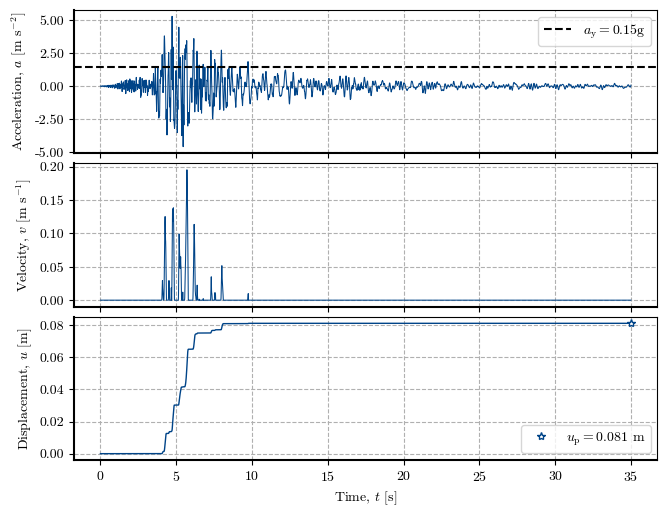Earthquake as a triggering factor of an infinite slope mechanism#
© 2024 Daniel F. Ruiz, Exneyder A. Montoya-Araque y Universidad EAFIT.
This notebook can be interactively run in Google - Colab.
This notebook runs the model pyNermarkDisp developed by Montoya-Araque et al. [2024] based on the classical sliding rigid block method by Newmark [1965].
Required modules and global setup for plots#
import os
import sys
import subprocess
if 'google.colab' in str(get_ipython()):
print('Running on CoLab. Installing the required modules...')
# subprocess.run('pip install ipympl', shell=True);
subprocess.run('pip install pynewmarkdisp', shell=True);
from google.colab import output, files
output.enable_custom_widget_manager()
else:
import tkinter as tk
from tkinter.filedialog import askopenfilename
import numpy as np
import pandas as pd
import matplotlib as mpl
import matplotlib.pyplot as plt
from pynewmarkdisp.newmark import direct_newmark, plot_newmark_integration
from pynewmarkdisp.infslope import factor_of_safety, get_ky
# %matplotlib widget
%matplotlib inline
mpl.rcParams.update({
"font.family": "serif",
"font.serif": ["Computer Modern Roman", "cmr", "cmr10", "DejaVu Serif"], # or
"mathtext.fontset": "cm", # Use Computer Modern fonts for math
"axes.formatter.use_mathtext": True, # Use mathtext for axis labels
"axes.unicode_minus": False, # Use standard minus sign instead of a unicode character
})
# Create a folder where the records will be saved
workdir = os.getcwd()
records_dir = os.path.join(workdir, "records")
os.makedirs(f"{records_dir}", exist_ok=True)
Functions#
def load_file(testing_data):
if testing_data:
url = "https://raw.githubusercontent.com/eamontoyaa/data4testing/main/pynewmarkdisp/"
# record = np.loadtxt(f"{url}earthquake_data_friuli.csv", delimiter=";", skiprows=1)
# record[:, 1] = - 2.0 * 9.81 * record[:, 1] # Convert to SI units
record = np.loadtxt(f"{url}earthquake_data_armenia1999.csv", delimiter=",")
elif testing_data is False and 'google.colab' in str(get_ipython()):
file = files.upload()
# Move the file to the records folder
os.rename(list(file.keys())[0], os.path.join(records_dir, list(file.keys())[0]))
record = np.loadtxt(os.path.join(records_dir, list(file.keys())[0]))#, delimiter=",")
else: # GUI for file selection from local machine if not in CoLab
tk.Tk().withdraw() # part of the import if you are not using other tkinter functions
file = askopenfilename()
# Move the file to the records folder
os.rename(file, os.path.join(records_dir, os.path.basename(file)))
record = np.loadtxt(os.path.join(records_dir, os.path.basename(file)))
time, accel = record.T
return time, accel
def get_arias_intensity(time, accel, g):
return np.trapz(y=accel**2, x=time) * np.pi / (2 * g)
def get_pgv(time, accel, g):
accel = 9.81 * accel / g # Earthquake acceleration to SI units
vel = np.cumsum(accel) * (time[1] - time[0])
return np.max(np.abs(vel))
def get_pga(accel, g):
return np.max(np.abs(accel / g))
Running a case#
testing_data = True # Set to False to use the GUI to load the data from an external file
Inputs (conditioning factors)#
# Geometry
β = 35 # [°] - Slope angle - Plane inclination
d = 3.0 # [m] - Depth of the slip surface - Block height
d_w = 3.0 # [m] - Depth of the water table
# Material parameters
φ = 27 # [°] - Friction angle
c = 15 # [kPa] - Cohesion
γ = 19 # [kN/m³] - Unit weight
Inputs (triggering factor - Earthquake record)#
time, accel = load_file(testing_data)
time, accel
(array([0.0000e+00, 5.0000e-03, 1.0000e-02, ..., 3.4985e+01, 3.4990e+01,
3.4995e+01]),
array([0.00246051, 0.00246493, 0.00246935, ..., 0.02309875, 0.05239547,
0.08169219]))
# Value of gravity acceleration in the same units as in the earthquake record
# g = 1.0 # → It means that acceleration units in the input file are given in [g]
g = 9.81 # → It means that acceleration units in the input file are given in [m/s²]
# g = 981 # → It means that acceleration units in the input file are given in [cm/s²]
PGA = get_pga(accel, g)
print(f"PGA: {PGA:.2f} g")
PGA: 0.54 g
Static factor of safety, \(\mathrm{FS}_\mathrm{static}\)#
fs = factor_of_safety(d, d_w, β, φ, c, γ, ks=0)
print(f"Static factor of safety: {fs:.2f}")
Static factor of safety: 1.29
Critical seismic coefficient \(k_\mathrm{y}\)#
ky = get_ky(d, d_w, β, φ, c, γ)
print(f"Critical seismic coefficient, ky: {ky:.2f}")
Critical seismic coefficient, ky: 0.15
Pseudo-static factor of safety, \(\mathrm{FS}_\mathrm{pseudostatic}\), when \(k_\mathrm{s}\) is 70% of \(k_\mathrm{y}\)#
ks = 0.7 * ky
fs_ks = factor_of_safety(d, d_w, β, φ, c, γ, ks)
print(f"Seismic coefficient, ks: {ks:.3f}")
print(f"Pseudostatic factor of safety: {fs_ks:.2f}")
decrease_fs = (fs - fs_ks) / fs * 100
print(f"Decrease in factor of safety: {decrease_fs:.2f} %")
Seismic coefficient, ks: 0.104
Pseudostatic factor of safety: 1.07
Decrease in factor of safety: 16.54 %
Pseudo-static factor of safety, \(\mathrm{FS}_\mathrm{pseudostatic}\), when \(k_\mathrm{s}\) is 50% of PGA#
ks = 0.5 * PGA
fs_ks = factor_of_safety(d, d_w, β, φ, c, γ, ks)
print(f"Seismic coefficient, ks: {ks:.3f}")
print(f"Pseudostatic factor of safety: {fs_ks:.2f}")
decrease_fs = (fs - fs_ks) / fs * 100
print(f"Decrease in factor of safety: {decrease_fs:.2f} %")
Seismic coefficient, ks: 0.270
Pseudostatic factor of safety: 0.83
Decrease in factor of safety: 35.56 %
Calculating and plotting \(u_\mathrm{p}\)#
permanent_disp = direct_newmark(time, accel, ky, g)
# permanent_disp = direct_newmark(time, accel, .135, g)
fig = plot_newmark_integration(permanent_disp)
fig.canvas.header_visible = False
fig.canvas.toolbar_position = 'bottom'
plt.show()


